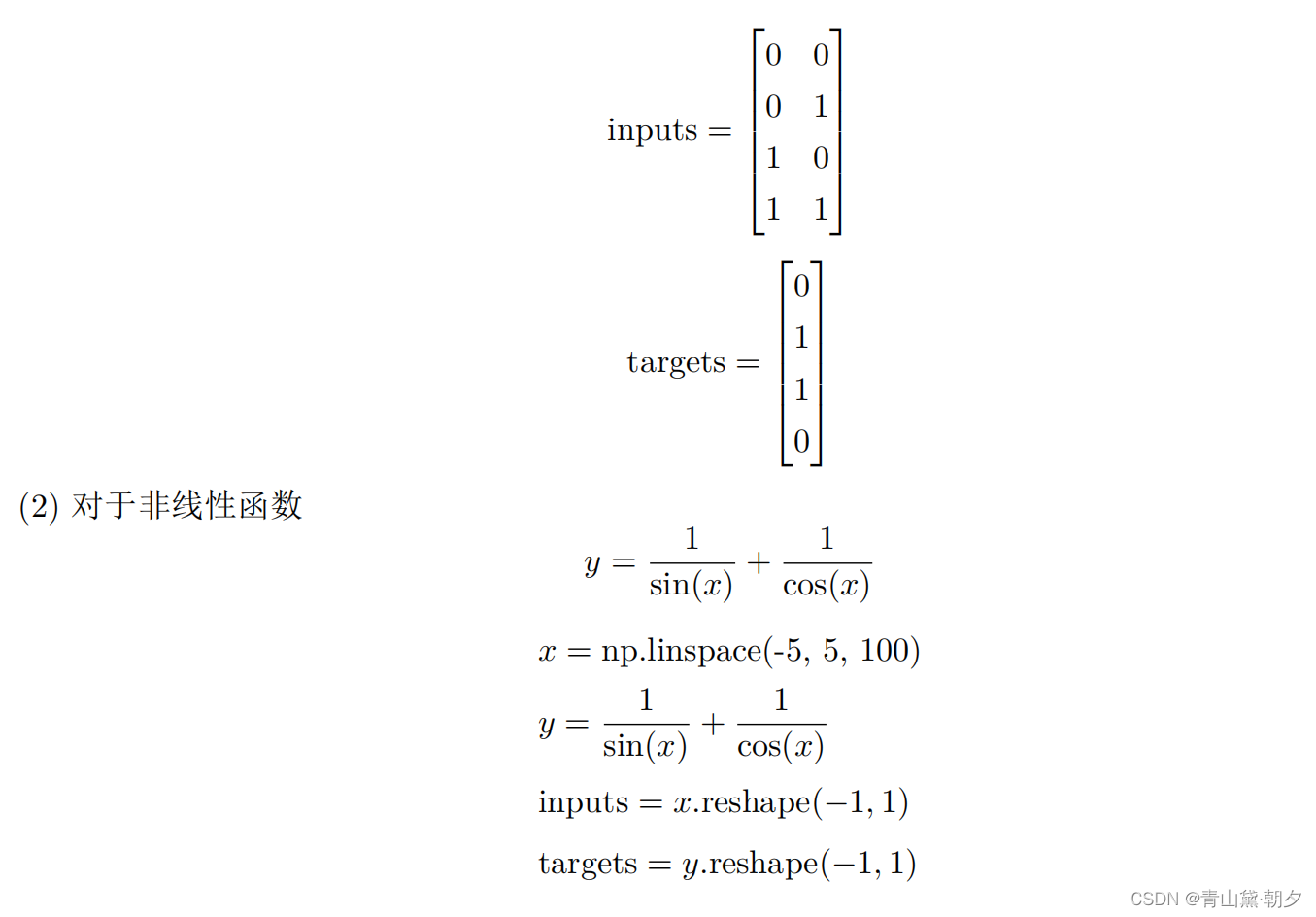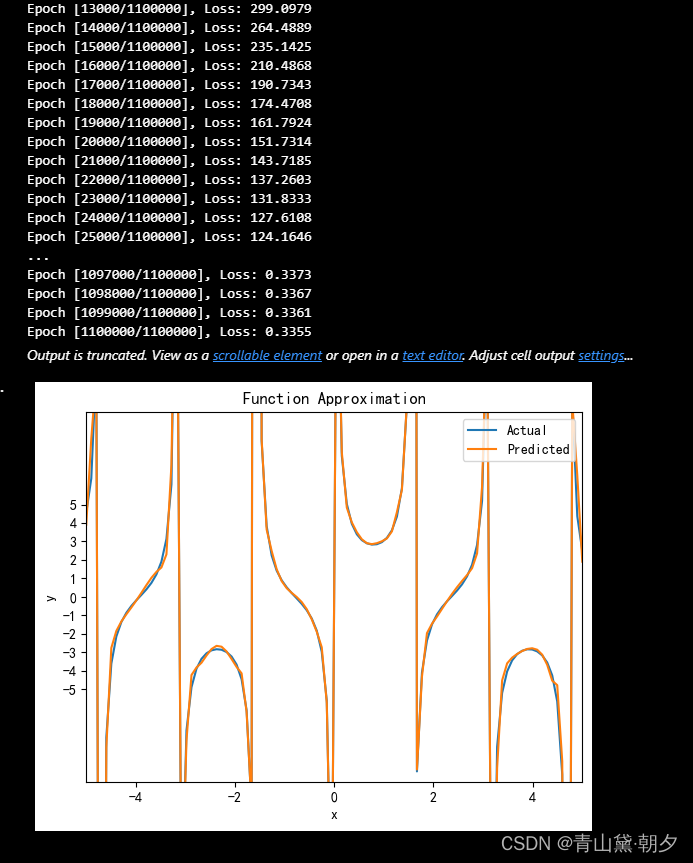Zza
2023 年 9 月 20 日
1.引言
函数逼近问题是指在不给出函数关系式的前提下, 仅通过大量的函数值对应实例, 对神经网络 进行训练,使得神经网络可以根据一个未知的自变量预测对应的应变量值。
2 实验设计
2.1 实验环境
• Python 3.9.13
• NumPy 库
• 神经网络类 NeuralNet(包含前向传播和反向传播方法)
• 均方误差损失函数 mse_loss
2.2 实验参数
(1) 对于函数 XOR
• 输入层节点数 input__size = 2
• 隐藏层节点数 hidden__size = 18
• 输出层节点数 output__size = 1
• 学习率 learning__rate = 0.01
• 训练迭代次数 num__epochs = 10000
(2) 对于非线性函数
y = \frac{1}{{\sin(x)}} + \frac{1}{{\cos(x)}}
• 输入层节点数 input__size = 1
• 隐藏层节点数 hidden__size = 100
• 输出层节点数 output__size = 1
• 学习率 learning__rate = 0.01
• 训练迭代次数 num__epochs = 1200000
3 实验步骤
3.1 初始化神经网络模型
model = NeuralNet(input__size, hidden__size, output__size)3.2 生成输入数据
(1) 对于函数 XOR

3.3 训练神经网络模型
for epoch in range(num_epochs):
# Forward pass
outputs = model.forward(inputs)
loss = mse_loss(targets, outputs)
# Backward pass and optimization (SGD)
model.backward(inputs, targets, outputs, learning_rate)
# Print loss every 1000 epochs
if (epoch+1) % 1000 == 0:
print('Epoch [{}/{}], Loss: {:.4f}'.format(epoch+1, num_epochs, loss))
3.4 使用训练好的模型进行预测
(1) 对于 XOR 函数
predicted = (model.forward(inputs) > 0.5).astype(int)(2)对于非线性函数
y = \frac{1}{{\sin(x)}} + \frac{1}{{\cos(x)}}
predicted = model.forward(inputs)4 实验结果 3
4 实验结果
(1) 对于 XOR 函数经过 10000 次迭代训练后, 损失值收敛到 0.00 预测出来的结果为小数, 因
此我做了近似
(2) 对于非线性函数
y = \frac{1}{{\sin(x)}} + \frac{1}{{\cos(x)}}


5 Python Code
import numpy as np
# Define the sigmoid activation function
def sigmoid(x):
return 1 / (1 + np.exp(-x))
# Define the derivative of the sigmoid function
def sigmoid_derivative(x):
return x * (1 - x)
# Define the mean squared error loss
def mse_loss(y_true, y_pred):
return np.mean((y_true - y_pred)**2)
# Define the neural network class
class NeuralNet:
def __init__(self, input_size, hidden_size, output_size):
# Initialize weights and biases
self.weights1 = np.random.randn(input_size, hidden_size)
self.bias1 = np.zeros((1, hidden_size))
self.weights2 = np.random.randn(hidden_size, output_size)
self.bias2 = np.zeros((1, output_size))
def forward(self, x):
# Perform forward pass
self.z1 = np.dot(x, self.weights1) + self.bias1
self.a1 = sigmoid(self.z1)
self.z2 = np.dot(self.a1, self.weights2) + self.bias2
self.a2 = self.z2 # Linear activation
return self.a2
def backward(self, x, y, y_pred, learning_rate):
# Compute gradients
m = x.shape[0]
dL_da2 = 2 * (y_pred - y) / m
dL_dz2 = dL_da2
dL_dw2 = np.dot(self.a1.T, dL_dz2)
dL_db2 = np.sum(dL_dz2, axis=0, keepdims=True)
dL_da1 = np.dot(dL_dz2, self.weights2.T)
dL_dz1 = dL_da1 * sigmoid_derivative(self.a1)
dL_dw1 = np.dot(x.T, dL_dz1)
dL_db1 = np.sum(dL_dz1, axis=0, keepdims=True)
# Update weights and biases
self.weights1 -= learning_rate * dL_dw1
self.bias1 -= learning_rate * dL_db1
self.weights2 -= learning_rate * dL_dw2
self.bias2 -= learning_rate * dL_db2
input_size = 1
hidden_size = 100
output_size = 1
learning_rate = 0.01
num_epochs = 1100000
# Create neural network model
model = NeuralNet(input_size, hidden_size, output_size)
# Generate input data
x = np.linspace(-5, 5, 100)
y = 1 / np.sin(x) + 1 / np.cos(x)
# Convert inputs and targets to numpy arrays
inputs = x.reshape(-1, 1) # Assuming you want 100 input features
targets = y.reshape(-1, 1)
# Train the model
for epoch in range(num_epochs):
# Forward pass
outputs = model.forward(inputs)
loss = mse_loss(targets, outputs)
# Backward pass and optimization (SGD)
model.backward(inputs, targets, outputs, learning_rate)
# Print loss every 1000 epochs
if (epoch+1) % 1000 == 0:
print('Epoch [{}/{}], Loss: {:.4f}'.format(epoch+1, num_epochs, loss))
# Predict using the trained model
predicted = model.forward(inputs)
# Plot results (similar to original code)
import matplotlib.pyplot as plt
plt.plot(x, y, label='Actual')
plt.plot(x, predicted, label='Predicted')
plt.xlabel('x')
plt.xlim(-5,5)
plt.ylabel('y')
plt.ylim(-10, 10)
plt.yticks(np.arange(-5, 6, 1))
plt.title('Function Approximation')
plt.legend()
plt.show()
inputs = np.array([[0, 0], [0, 1], [1, 0], [1, 1]])
targets = np.array([[0], [1], [1], [0]])
# Define hyperparameters
input_size = 2
hidden_size = 18
output_size = 1
num_epochs = 10000
learning_rate = 0.01
# Initialize the neural network
model = NeuralNet(input_size, hidden_size, output_size)
# # Training loop
for epoch in range(num_epochs):
# Forward pass
outputs = model.forward(inputs)
loss = mse_loss(targets, outputs)
# Backward pass and optimization (SGD)
model.backward(inputs, targets, outputs, learning_rate)
# Print loss every 1000 epochs
if (epoch+1) % 1000 == 0:
print('Epoch [{}/{}], Loss: {:.4f}'.format(epoch+1, num_epochs, loss))
#Predict using the trained model
predicted = model.forward(inputs)
predicted_I_want = (model.forward(inputs) > 0.5).astype(int)
# Print the predictions
print("Predicted:")
print(predicted)
print("predicted_I_want:")
print(predicted_I_want)
# Print the targets
print("\nTargets:")
print(targets)
7 结论
本实验成功地展示了如何使用反向传播算法来训练神经网络模型, 并对特定数据集进行预测。 通过调整不同的超参数,可以进一步优化模型的性能,以适应不同的任务需求。
训练参数很重要




















 1万+
1万+











 被折叠的 条评论
为什么被折叠?
被折叠的 条评论
为什么被折叠?








